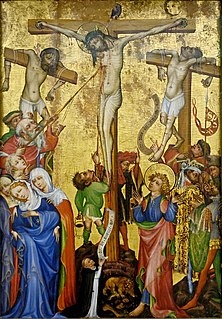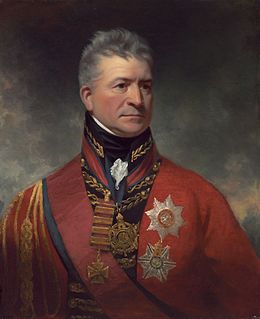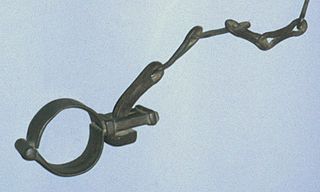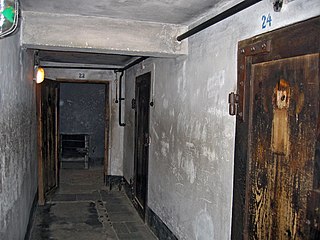
A knout is a heavy scourge-like multiple whip, usually made of a series of rawhide thongs attached to a long handle, sometimes with metal wire or hooks incorporated. The English word stems from a spelling-pronunciation of a French transliteration of the Russian word кнут (knut), which simply means "whip".

Crucifixion is a method of capital punishment in which the victim is tied or nailed to a large wooden beam and left to hang until eventual death from exhaustion and asphyxiation. It was used as a punishment by the Romans, among others. Crucifixion has been used in parts of the world as recently as the twentieth century.

A pendulum is a weight suspended from a pivot so that it can swing freely. When a pendulum is displaced sideways from its resting, equilibrium position, it is subject to a restoring force due to gravity that will accelerate it back toward the equilibrium position. When released, the restoring force acting on the pendulum's mass causes it to oscillate about the equilibrium position, swinging back and forth. The time for one complete cycle, a left swing and a right swing, is called the period. The period depends on the length of the pendulum and also to a slight degree on the amplitude, the width of the pendulum's swing.

Flagellation, flogging or whipping is the act of beating the human body with special implements such as whips, rods, switches, the cat o' nine tails, the sjambok, the knout, etc. Typically, flogging is imposed on an unwilling subject as a punishment; however, it can also be submitted to willingly for sadomasochistic pleasure, or performed on oneself, in religious or sadomasochistic contexts.

Handcuffs are restraint devices designed to secure an individual's wrists in proximity to each other. They comprise two parts, linked together by a chain, a hinge, or rigid bar. Each cuff has a rotating arm which engages with a ratchet that prevents it from being opened once closed around a person's wrist. Without the key, the handcuffs cannot be removed without specialist knowledge, and the handcuffed person cannot move their wrists more than a few centimetres or inches apart, making many tasks difficult or impossible.

Lieutenant-General Sir Thomas Picton was a Welsh officer of the British Army who fought in the Napoleonic Wars. According to the historian Alessandro Barbero, Picton was "respected for his courage and feared for his irascible temperament". The Duke of Wellington called him "a rough foul-mouthed devil as ever lived", but found him capable.

The strappado, also known as corda, is a form of torture wherein the victim's hands are tied behind his back and suspended by a rope attached to the wrists, typically resulting in dislocated shoulders. Weights may be added to the body to intensify the effect and increase the pain. This kind of torture would generally not last more than an hour without rest, as it would likely result in death.

The term boot refers to a family of instruments of torture and interrogation variously designed to cause crushing injuries to the foot and/or leg. The boot has taken many forms in various places and times. Common varieties include the Spanish boot and the Malay boot. One type was made of four pieces of narrow wooden board nailed together. The boards were measured to fit the victim's leg. Once the leg was enclosed, wedges would be hammered between the boards, creating pressure. The pressure would be increased until the victim confessed or lost consciousness. Newer variants have included iron vises—sometimes armed with spikes—that squeezed feet and metal frames employed red-hot. John Spreul is reported to have been tortured with two different boots. In general, the boot was an effective and mechanically elegant torture device and was widely employed throughout Europe to extract information.

The cat o' nine tails, commonly shortened to the cat, is a type of multi-tailed flail that originated as an implement for severe physical punishment, notably in the Royal Navy and British Army, and also as a judicial punishment in Britain and some other countries.

Legcuffs are physical restraints used on the ankles of a person to allow walking only with a restricted stride and to prevent running and effective physical resistance.

The rack is a torture device consisting of a rectangular, usually wooden frame, slightly raised from the ground, with a roller at one or both ends. The victim's ankles are fastened to one roller and the wrists are chained to the other. As the interrogation progresses, a handle and ratchet mechanism attached to the top roller are used to very gradually retract the chains, slowly increasing the strain on the prisoner's shoulders, hips, knees, and elbows and causing excruciating pain. By means of pulleys and levers, this roller could be rotated on its own axis, thus straining the ropes until the sufferer's joints were dislocated and eventually separated. Additionally, if muscle fibres are stretched excessively, they lose their ability to contract, rendering them ineffective.

A cangue or tcha is a device that was used for public humiliation and corporal punishment in East Asia and some other parts of Southeast Asia until the early years of the twentieth century. It was also occasionally used for or during torture. Because it restricted a person's movements, it was common for people wearing cangues to starve to death as they were unable to feed themselves.

Human branding or stigmatizing is the process by which a mark, usually a symbol or ornamental pattern, is burned into the skin of a living person, with the intention that the resulting scar makes it permanent. This is performed using a hot or very cold branding iron. It therefore uses the physical techniques of livestock branding on a human, either with consent as a form of body modification; or under coercion, as a punishment or to identify an enslaved, oppressed, or otherwise controlled person. It may also be practiced as a "rite of passage", e.g. within a tribe, or to signify membership of or acceptance into an organization.

Foot whipping, falanga or bastinado is a method of inflicting pain and humiliation by administering a beating on the soles of a person's bare feet. Unlike most types of flogging, it is meant more to be painful than to cause actual injury to the victim. Blows are generally delivered with a light rod, knotted cord, or lash.

Bilboes are iron restraints normally placed on a person's ankles. They have commonly been used as leg shackles to restrain prisoners for different purposes until the modern ages. Bilboes were also used on slave ships, such as the Henrietta Marie. According to legend, the device was invented in Bilbao, Basque Country within Spain, and was imported into England by the ships of the Spanish Armada for use on prospective English prisoners. However, the Oxford English Dictionary notes that the term was used in English well before then.
Breaking is a martial arts technique that is used in competition, demonstration and testing. Breaking is an action where a martial artist uses a striking surface to break one or more objects using the skills honed in their art form. The striking surface is usually a hand or a foot, but may also be a fingertip, toe, head, elbow, knuckle, or knee. The most common object is a piece of wood or brick, though it is also common to break cinder blocks, glass, or even a piece of metal such as steel bars. Glass is usually discouraged, since its shards may cause injury when broken.

A picket is a soldier, or small unit of soldiers, placed on a defensive line forward of a friendly position to provide timely warning and screening against an enemy advance. It can also refer to any unit performing a similar function.

A standing cell is a special cell constructed so as to prevent the prisoner from doing anything but stand. The Stehbunker was used in Nazi concentration camps during the Third Reich as a punishment. Standing cells were also used during Joseph Stalin's purges in the Soviet Union. Some standing cells were large enough for only one person, others held as many as four people.

A tromba marina, marine trumpet or nuns' fiddle, is a triangular bowed string instrument used in medieval and Renaissance Europe that was highly popular in the 15th century in England and survived into the 18th century. The tromba marina consists of a body and neck in the shape of a truncated cone resting on a triangular base. It is usually four to seven feet long, and is a monochord. It is played without stopping the string, but playing natural harmonics by lightly touching the string with the thumb at nodal points. Its name comes from its trumpet like sound due to the unusual construction of the bridge, and the resemblance of its contour to the marine speaking-trumpet of the Middle Ages.















